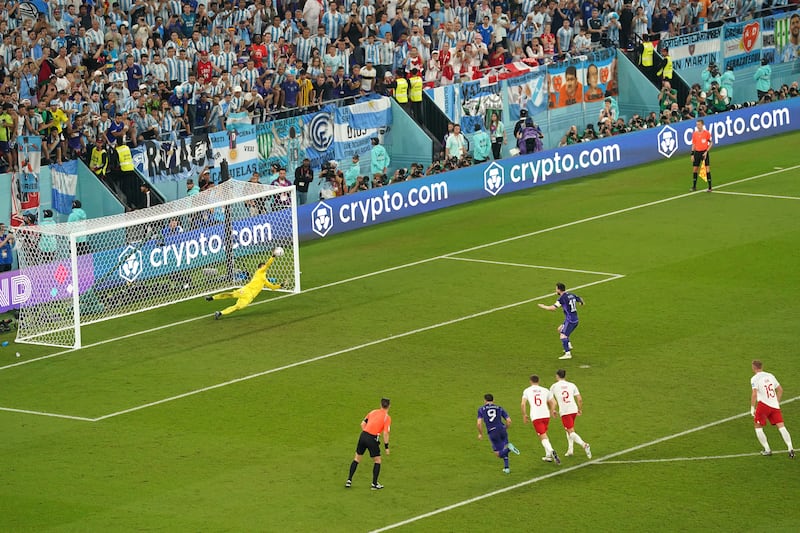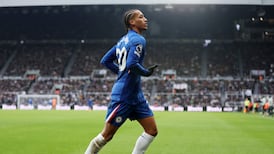Wojciech Szczesny laughed bitterly at the referee’s decision to award a penalty for his marginal foul on Lionel Messi and prepared to face down the world’s greatest player.
After 999 career appearances, Messi doesn’t seem like the kind to sit up late studying opposition research dossiers, but Szczesny knows there must be at least a chance his opponent will have seen his spectacular penalty save against Saudi Arabia in the last game.
The Polish goalkeeper grins, makes his eyes flash with a glint of madness and puffs himself up to look as massive as he can, bouncing high on the balls of his feet.
What should the penalty taker do in this situation? Zinedine Zidane used to make his face completely expressionless, and stare at the goalkeeper like a shark.
READ MORE
Messi is incapable of assuming Zidane’s mask of composure. He stands with his head slightly bowed, rubbing his beard, scratching his face, radiating stress. Did he just steal a little glance at the right side of Szczesny’s goal?
He knows Szczesny will have seen his own penalty against the Saudis, when he rolled the ball left sending the goalkeeper the wrong way.
He tries the opposite penalty, high and hard to the right, but Szczesny flings himself to his left and saves it one-handed.
Messi doesn’t freeze as players who miss penalties often do, doesn’t really even seem surprised, doesn’t turn to look at his team-mates, just jogs dejectedly to take the corner.
[ Lionel Messi and Argentina live to fight another day as they secure safe passageOpens in new window ]
It is amazing – and not a little endearing – that this player, the best technical footballer of all time, can still be so obviously vulnerable, so fallible at certain high-pressure moments, and still struggle to control negative spirals of thought when singled out in the penalty kick situation. This was his 31st penalty miss from 137 attempts, and his second in successive World Cups after his miss against Iceland in 2018. It means his success rate from the spot is 77 per cent – almost exactly average.
The Argentina fans who make up more than 90 per cent of the crowd at the 974 Stadium try to encourage him, chanting, Messi, Messi, Messi!
He just has to keep playing his game, which today is all about lurking in the spaces left by others as they play theirs.
One of the dramas of the group stage was when Germany’s Ilkay Gündogan accused his team-mates of not showing for the ball after the defeat against Japan. Making yourself available to receive the pass is something which for most players involves constant movement and unceasing effort.

Players adapt to the ageing process in different ways but almost universally they will start to run less. Messi started running less when he was about 25. Along with Robert Lewandowski he was the top walker of the first two rounds of matches: he covered 9.6km at a stroll, 100 metres less than Lewandowski, who is only 12 months his junior.
Now 35, Messi prefers to let the space come to him. If he sees the ball moving in his direction he will often start walking the other way, knowing that is where the space is more likely to appear. When he sees everyone running in one direction, he stands there and lets them run past, and the space appears around him. If an Argentina attack breaks down and the opponents move up the pitch, Messi will often just stand there, 20 yards offside, waiting for the game to come back to him. If the game moves quickly towards the end he’s attacking, he doesn’t run to join the attack, he lets his team-mates run past and walks after them. As Pep Guardiola always says, the key is not to occupy the goalscoring positions, but to arrive into them at the right moment.
[ Why Argentina v Saudi Arabia is RTÉ's most-streamed World Cup matchOpens in new window ]
Clearly, this approach is not open to everyone. You need to be pretty important for your team-mates to put up with it. And only someone who knew they were the most important person on the pitch could be so relaxed about spending so much time detached from the game going on around them.
And one obvious cost of the method is that the areas where Messi does receive the ball are not dangerous positions. In his prime Messi was moving constantly between the defensive and midfield lines to receive the ball. Now he’s standing and waiting outside the lines, in space nobody is trying to defend.
The reason why Argentina put up with it is that these positions become dangerous when it’s Messi on the ball.
The defenders know something is coming but they don’t know what. Will he play a one-two and run between the lines? Will he try a little dribble to make space for a shot? Will he spin the ball out to the left wing? Will he simply lay it off and wait for it to come back to him.
This is why Messi is still so great to watch, even though he is nothing like the irresistible force he once was. Contemporaries like Lewandowski and Cristiano Ronaldo have adapted to getting old by paring everything back and focusing on getting on the end of things.
Messi still wants to create the shape of the attacks. He can’t do as much as he used to, he can’t run past defenders any more (although he can shuffle past them by putting them off-balance), but he is still taking responsibility, and everything he does retains the fascination of unpredictability.
Alexis Mac Allister’s goal at the start of the second half releases some of the pressure on Messi after his penalty miss. In the 53rd minute, courtesy of a Polish turnover in Argentina’s half, he received the ball between the lines and turned to run at the back-pedalling Polish defenders. Everyone knows what he wants to do: get within shooting range, shuffle on to his left and shoot. He fakes a shot and takes a touch and fakes a shot and takes a touch and pulls the trigger ... and comically slices the ball up in the air.
He laughs and again the crowd sing Messi, Messi, Messi, and bow in mock-worship.
How must it feel for the other 21 players knowing they are sharing a pitch with a football deity. They must feel like normal people do when an ex-professional turns up at the five-a-side. Even Lewandowski, who has inherited Messi’s old spot as the top player at Barcelona, is ordinary by comparison, and it must be hard for him to take.
A couple of minutes after Messi’s run, Lewandowski gets the ball in space in a similar situation, just inside Argentina’s half, but even though he can sprint faster than Messi, him being on the ball in this position means something completely different. You know he is going to lay it off and try to get in the box; he does this and his team-mate loses it.
Lewandowski is brilliant, but predictable. and Poland don’t have the ability to get him into the kind of dangerous positions where he can make things happen. Messi takes the ball in the least promising positions and makes things happen. That’s why, nearly 1,000 games in, he remains as mesmerising as ever.














